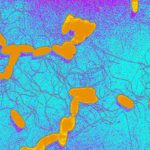Lien vers Pubmed [PMID] – 31323053
Lien DOI – 10.1371/journal.pone.0220145
PLoS ONE 2019 ; 14(7): e0220145
The epidemiology of human Salmonella enterica infections in Guadeloupe (French West Indies) appears to be specific, with a higher prevalence of the subspecies enterica serovars Panama and Arechavaleta (Panama and Arechavaleta) than in other regions. A study was performed in Guadeloupe to identify the reservoir of Salmonella serovars by comparing their distribution in warm- and cold-blooded animals and in humans living in Guadeloupe and mainland France. Furthermore, a case-control study was conducted in 2012-2013 to identify the main epidemiologic risk factors for S. enterica infection among children under 15 years of age. Between June 2011 and December 2014, feces from 426 reptiles (322 anoles, 69 iguanas and 35 geckos) and 50 frogs distributed throughout Guadeloupe and nearby islands were investigated. The frequency of S. enterica carriage was 15.0% (n = 64) in reptiles but varied by species. The only significant risk factor for S. enterica infection was a more frequent presence of frogs in the houses of cases than in those of controls (P = 0.042); however, isolates were not collected. Panama and Arechavaleta were the two serovars most often recovered between 2005 and 2014 from humans living in Guadeloupe (24.5% (n = 174) and 11.5% (n = 82), respectively), which is in contrast to the low prevalence in mainland France (0.4%). Their presence at low frequencies in wild reptiles (4.6% (n = 3) and 3.1% (n = 2), respectively) and pigs (7.5% (n = 5) and 1.5% (n = 1), respectively) suggests a broad host range, and humans may be infected by indirect or direct contact with animals. These serovars are probably poorly adapted to humans and therefore cause more severe infections. The unusual subspecies houtenae serovar 43:z4,z32:- was a major subspecies in wild reptiles (24.6%, n = 16) and humans (9.4%, n = 67) but was not recovered from warm-blooded animals, suggesting that reptiles plays a key role in human infection.

